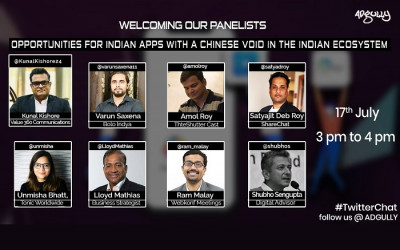It’s now or never – How Indian players can make the most of Chinese apps ban
The ban on 59 Chinese apps by the Indian Government has opened up a world of opportunities for homegrown players to fill in the void. The ban also includes hugely popular TikTok app. Soon after the ban, TikTok users were switching on to Indian apps such as Roposo, Mitron, Chingari, giving a boost to a more Atmanirbhar app economy.
While the opportunities are great, will the Indian apps be able to hold their own against global players like Instagram Reels, which recently launched in the country? How does the entire Indian app economy function? How can Indian start-ups monetise in a more efficient manner? How to create differentiation in this field and not end up as mere TikTok clones?
Questions are many, and to tackle them and shed more light on this developing field, Adgully had lined up a cross-section of digital experts who are among those spearheading this ecosystem as part of our flagship #TwitterChat property for the discussion on ‘Opportunities for Indian Apps with a Chinese Void In the Indian Ecosystem’.
Joining in the discussions were:
Kunal Kishore, Founder, Value 360 Communications (@KunalKishore24) (Moderator)
Lloyd Mathias, Business Strategist (@LloydMathias)
Unmisha Bhatt, Chief Strategy Officer, Tonic Worldwide (@unmisha)
Varun Saxena, Founder, Bolo Indya (@varunsaxena11)
Shubho Sengupta, Digital Advisor (@shubhos)
Satyajit Deb Roy, Director - Sales, ShareChat (@satyadroy)
Amol Roy, Founder, TheShutterCast (@amolroy)
Ram Malay, CEO, Webkonf Meetings (@ram_malay)
Tapping the huge opportunity
https://twitter.com/KunalKishore24/status/1284058317233385472?s=19
With 67 per cent of Indian smartphone users being captive audiences to these apps, Unmisha Bhatt believed that there is immense opportunity for Indian apps to lap up. According to her, it all depended on their agility and user experience now.
Agreeing with her, Satyajit Deb Roy, too, felt that this will create a level playing field for the Indian start-up ecosystem. “Content and social media have traditionally been a true organic play. However, billions of marketing dollars by foreign entities made it unfair and hostile for homegrown content/ social start-ups,” he noted.
Calling it an “unmatched opportunity”, Varun Saxena remarked that it is a unique short term window that is available for all the Indian founders and apps to create a strong base for them. He further said, “The ban on Chinese apps has significantly reduced the customer acquisition and distribution costs, leading to many users trying out Indian alternatives.”
In a similar vein, Amol Roy, too, said that with the recent ban on Chinese apps, there is a huge void created in the market. He added that it has opened up more and more opportunities for Indian companies in not only the same domains, but many other smaller sub-domains and for many other small underlying technologies as well.
Calling the ban unfortunate, Shubho Sengupta said that it was inevitable, given the kind of data that was being compromised. At the same time, it has opened up many windows of opportunities. “Also, Indian apps need to think of the world as consumer base, and not just India,” he advised, adding, “The other thing is that India is one of the highest consumers of apps, probably in the top 3, but not even in top 20 list of app developers. So, it is now or never!”
Ram Malay remarked, “With the ban on TikTok, Shareit, Vmate social platforms, Indian apps are all in race to become alternatives options for the Indian digital consumers, provided all apps provide sustainable platforms which meet demands of customers.”
For Lloyd Mathias, with the ban, huge opportunities have opened up in areas like short video formats and some utilities like scanning.
State of the Indian app ecosystem today
https://twitter.com/KunalKishore24/status/1284060331916922886?s=19
The panellists were in unison that Indian app ecosystem today is standing at the best possible position. As Sengupta noted, “We are amongst the top consumers of apps globally.” At the same time, there were some areas that needed immediate attention.
First and foremost is that India is not even in Top 20 global list of app creators. Roy elaborated on this, saying, “At present, we have a few very good apps available. But we need to focus more on the technologies used as well as on making the app global. The major challenge is to understand the importance of an app that can be scaled for a larger user base.” Bhatt, too, believed that while India has the talent, we just need to scale and build for not just India, but the global markets. She added that, “The Indian app ecosystem is at now at a new inflection point. Being a mobile first market, sky is the limit.”
According to Saxena, while opportunities are immense and widely known, challenge for every Indian app would be to retain the users who are coming to try out the product. The race is not for user acquisition for Indian apps today, but to retain the users. He believed that the next 3 months would decide who shall emerge as the winner amongst Indian apps, and who would be the top challenger for Chinese apps, when and if they returned.
Malay added here, “From video sharing to productivity, entertainment, browsing and gaming areas – we now have lucrative options for the Indian digital segment at a time when the global start-up ecosystem and investors are facing challenges. The COVID-19 impact and Government policies have led to huge changes.”
“This is an opportunity for India to rewrite history and emerge as a technology superpower. We need to remain uniquely Indian, understand our people, with an emphasis on the diversity of our languages and culture, and build products accordingly,” was Deb Roy’s advice.
To catch the complete conversation, follow @adgully on Twitter and stay tuned for #TwitterChat every Friday from 3 pm to 4 pm.




Share
Facebook
YouTube
Tweet
Twitter
LinkedIn